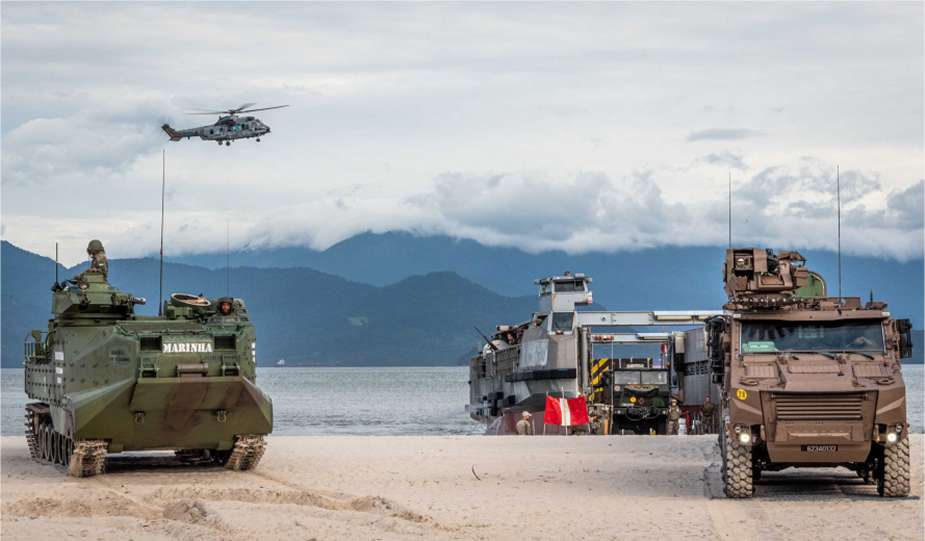Breaking news
French Army deploys Griffon armored vehicle in amphibious joint exercise with Brazil.
As reported by the General Staff of the French Army on April 20, 2024, the armed forces of Brazil and France concluded a joint amphibious exercise on Marambaia Island, which featured several military vehicles, such as the Griffon and the AAV-7. The exercise, a component of the 'Jeanne d'Arc 2024' operation, involved approximately 2,250 military personnel, with 1,460 from the Brazilian Navy and 790 from the French Armed Forces.
Follow Army Recognition on Google News at this link

This joint amphibious exercise between France and Brazil featured several military vehicles, such as the Griffon 6x6 armored vehicle and the AAV-7 amphibious tracked vehicle. (Picture source: French Navy)
The joint operation was structured into two primary phases. The initial maritime phase, conducted from April 14th to 16th, 2024, focused on maritime drills, including amphibious raids near the Marambaia Island Training Center, aimed to refine tactics and naval capabilities. The second phase, held from April 17th to 20th, 2024, centered on port-based operations and logistics, addressing both tactical execution and logistical management.
Both nations deployed various ground, naval, and air assets during the exercise. From Brazil, the multipurpose aircraft carrier Atlântico, the Liberal Frigate, and the Marambaia General Cargo Landing Ship were deployed, along with support from a fleet of helicopters, including the UH-12 Esquilo, UH-15 Super Cougar, and SH-16 Seahawk. The French contingent included the amphibious assault ship Tonnerre, the frigate Guépratte, and aerial support from Gazelle and Dauphin helicopters, in addition to specialized amphibious troops.
The broader context of this joint amphibious exercise included the departure of the French amphibious assault ship Tonnerre and the frigate Guépratte from Toulon Naval Base on February 19, 2024. This deployment, part of the annual Jeanne d'Arc mission, aims to provide training for French naval academy cadets through operational presence and engagement across South America. This year's mission includes around 800 service members, featuring 162 naval cadets and a French Army battlegroup comprising light cavalry, infantry, and combat engineers, along with aviation and medical teams. Planned for 149 days, the deployment involves multiple amphibious exercises across Brazil, Chile, and the United States, as well as 11 port visits.
An important aspect of the exercise was the deployment of armored vehicles, including the French Griffon armored vehicle and the AAV-7 amphibious vehicles from the Brazilian Marine Corps. The Griffon is a 6x6 multi-role armored vehicle developed by a consortium of French companies, including Nexter Systems, Renault Trucks Defense, and Thales, for the French Army's SCORPION modernization program. It aims to replace the older Véhicule de l'Avant Blindé (VAB) and features a modular design adaptable for various functions such as troop transport, command post, artillery observation, self-propelled mortar, and medical evacuation. The Griffon has a crew capacity of two and space for eight additional troops, and offers protection against small arms fire, artillery splinters, IEDs, mine blasts, and chemical, biological, radiological, and nuclear (CBRN) threats. Additionally, the vehicle is equipped with a remote-controlled weapon station (RCWS) capable of mounting a 12.7mm or 7.62mm machine gun or a 40mm automatic grenade launcher.
Meanwhile, the Brazilian Marine Corps deployed at least one of their 49 AAV-7 tracked amphibious vehicles, mainly employed to transport troops and equipment from naval vessels to shore in amphibious assault operations. Since its introduction in 1972, the AAV-7, initially designated as the LVTP-7, has received several updates to improve its engine, transmission, and armament capabilities. The AAV-7 is equipped with engines such as the Detroit Diesel 8V-53T and the Cummins VT 400 903, and it uses a combination of tracks and water jets for movement, reaching speeds of up to 45 mph on land and 8 mph in water. Armament configurations on the AAV-7 include a .50 caliber M2HB machine gun and a Mk 19 40 mm grenade launcher, enabling it to support amphibious assault operations. The vehicle can carry up to 25 Marines along with a crew of three, facilitating both troop transport and logistical support during missions.























